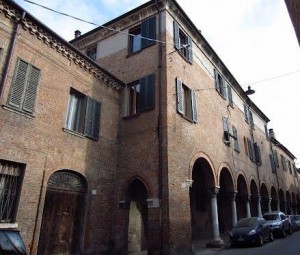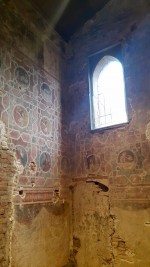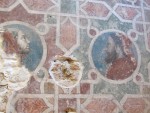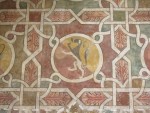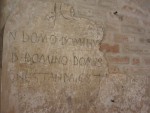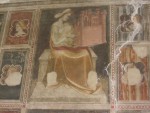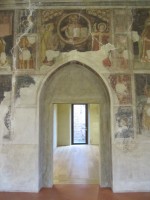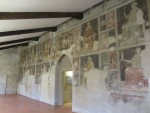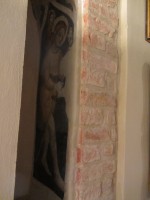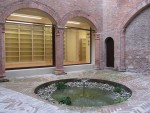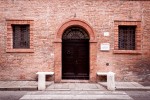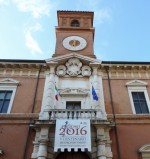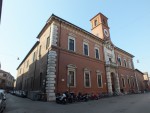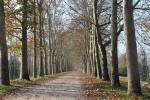Casa Minerbi - Dal Sale
Casa Minerbi is located in Via Gioco del Pallone, adjacent to the residences of the Ariosto family. Surely Ludovico must have frequented this place, on whose walls appear frescoes with scenes and figures still visible today, no doubt which inspired the mythical and fantastical imagery of Ludovico Ariosto.
The structure
The building appears as a cluster of houses, with irregular floor plans, closely connected to each other, present in Ferrara from 1205 to 1587, belonging during the 14th century to the noble Del Sale (or Dal Sale) family. Many Ferrarese documents record the activities of some members of the family engaged in prominent roles in the municipal administration, closely linked both with ecclesiastical power and with the Este court of Niccolò III, Borso, and Ercole I d'Este. The complex of buildings stands out for the modifications made by the Del Sale family starting from 1330 and for all the years they resided in the palace. Further characterizing the area with a clear medieval imprint is the presence of Palazzo Paradiso in the immediate vicinity. This is an imposing building constructed during the course of the 14th century, precisely in 1391, by Alberto V d'Este, which originally housed the University with its main entrance facing Via Gioco del Pallone.
"In its entirety, the small palace has a very simple distribution, with an exact correspondence between the ground floor and the first floor, whose main walls are continuous. On the ground floor, from the loggia, one enters three rooms, of which the two larger lateral ones bear traces of frescoes and decorated wooden ceilings from the 15th century. [...] The upper floor is divided in turn into two large frescoed rooms, and from the landing of the intermediate space, the pointed arch door opens (or rather, opened) to the 'hall,' also frescoed on the three internal sides, which occupies the entire width of the building" (Ragghianti 1971, pp. 8-9).
The frescoes in the 'Furioso'
Casa Minerbi del Sale bordered the grand mansion of the Ariosti family on Via Gioco del Pallone, the ancient street where students used to play football, hence decreeing its name. The frescoes preserved in the main building, partly attributed to the so-called "Master of Casa Minerbi," are dated between 1360 and 1370. They are mainly found in the two main halls, the Hall of Coats of Arms and the Hall of Vices and Virtues, and constitute the most significant surviving pieces of Ferrarese artists' work from the 14th century: according to Ragghianti, the work is "capital, of greater importance”. It is not incorrect to think that, given the proximity of the residences, Ariosto knew these frescoes and fuelled his fervid imagination by drawing inspiration from the scenes depicted there. As noted by Arturo Malagù, the warrior handmaidens of the sorceress Logistilla indeed seem to suggest the four Virtues represented in the palace halls.
Giunte son quattro donne in su la spiaggia,
che subito ha mandate Logistilla:
la valorosa Andronica e la saggia
Fronesia e l’onesta Dicilla
E Sofrosina casta, che, come aggia
Quivi a far più che le altre sfavilla.
(O. F. X, 52)
In the four women, we find allegorical figures corresponding to the virtues of Fortitude, Prudence, Justice, and Temperance, while the sorceress Alcina finds her counterpart among the Vices, depicted as Incontinence. Continuing to traverse the rooms of the dwelling, other images recall the protagonists of the Furioso such as that of the hunter blowing the horn, which, in its intensity and rhythm, evokes the episode of the terrifying sound of the enchanted horn with which Astolfo defeats the murderous fury of the women in Canto XX:
Come aiutar ne le fortune estreme
Sempre si suol, si pone il corno in bocca.
Par che la terra e tutto il mondo trieme,
quando l’orribil suon ne l’aria scocca.
Sì nel cor de la gente il timor preme,
che per disio di fuga si trabocca
giù del teatro sbigottita e smorta,
non che lasci la guardia de la porta.
(O. F. XX, 88)
and with which he drives away the harpies that assail, infesting it, Senapo's table.
E così in una loggia s’apparecchia
Con altra mensa altra vivanda nuova.
Ecco le arpie che fan l’usanza vecchia:
Astolfo il corno subito ritrova.
Gli augelli, che non han chiusa l’orecchia,
udito il suon, non puon stare alla prova,
ma vanno in fuga pien di paura,
né di cibo, né di altro hanno più cura.
(O. F. XXXIII, 125)
Pio Rajna's studies on the sources of Orlando furioso find in Norse mythology a horn with the same magical power, an element that Ariosto decided to adopt to better motivate the flight of the harpies, inserting it into the story of Astolfo in Ethiopia within the Furioso. Among the subjects depicted in the frescoes of the Hall of Allegories, other characters can be noticed: among them, one man is caught in the act of running while shouting at the other, who, with a crown of chicken feathers, grips a gnarled stick, representing Madness. A little further on, a man is depicted trying to tear his clothes from his body, representing the allegory of Wrath. These images immediately evoke the madness of Orlando, driven insane by the unrequited love for the beautiful Angelica.
…e in loco capitaro,
ove videro un uomo tanto feroce,
che nudo e solo a tutto l’campo nuoce.
Menava un suo baston di legno in volta,
che era sì duro e sì grave e sì fermo,
che declinando quel, facea ogni volta
cader a terra un uomo peggio ch’infermo.
(O. F. XXXIX, 36-37)
Just as the events of the poem, the scenes depicted by the master of Casa Minerbi tell of a real, everyday life. "In this cycle, the secular painterly vein breathes and pulsates with undisturbed serenity, speaking not to the future but to the present, and courtly or sacred culture is bent to a temporality felt as an essential value to be lived fully and incomparably with every cult, perhaps with challenge, a vein that circulates throughout Italy after the mid-fourteenth century" (Ragghianti 1976, pp. 23-24).
The Bassani Study Center
Bibliography
- Giulio Bertoni, L’Orlando furioso e la Rinascenza a Ferrara, Cav Orlandini, Modena 1919
- Gianna Pazzi, Ferrara antica e Ferrara d'oggi (1000-1927), Lunghini & Bianchini, Firenze 1929
- Carlo Ludovico Ragghianti, Gli affreschi di Casa Minerbi a Ferrara, Associazione fra le Casse di Risparmio Italiane, L'Aquila 1970
- Raffaele Belvederi, Virgilio Ferrari, Arturo Malagù, Ferrara e l'Ariosto. La Ferrariae Decus nel V centenario della nascita del poeta, SATE, Ferrara 1974
- Pio Rajna, Le fonti dell'Orlando furioso, Sansoni, Firenze 1975
- Ludovico Ariosto, Cesare Segre, Orlando furioso, I Meridiani Mondadori, Milano 1976
- Antonio Panizzi, Alessandro Marcigliano, La vita di Ariosto, Atti della Deputazione Provinciale Ferrarese di Storia Patria, SATE, Ferrara 1988
Sitography
- http://www.artecultura.fe.it/1916/casa-minerbi- dal-sale
- http://www.listonemag.it/2014/04/14/alla-scoperta-di-casa-minerbi-dal-sale/
- https://www.youtube.com/watch?v=uhYzOe_lgN4
- https://www.ferraraterraeacqua.it/it/ferrara/scopri-il-territorio/arte-e-cultura/ville-dimore-teatri-storici/casa-minerbi-dal-sale
- https://archibiblio.comune.fe.it/2521/centro-studi-bassaniani-ferrara
- https://archibiblio.comune.fe.it/2523/presentazione-di-portia-prebys
- https://archibiblio.comune.fe.it/2522/presentazione-di-gianni-venturi
- https://patrimonioculturale.regione.emilia-romagna.it/notizie/2023/case-studi-illustri-strutture-riconosciute
Fototeca
Related places
Related Itineraries
Compiling entity
- Assessorato alla Cultura e al Turismo, Comune di Ferrara
Author
- Stefania De Vincentis
- Barbara Pizzo

